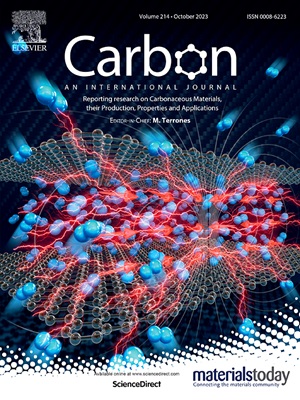Heterostructured MoO2@rGO facilitates enhanced kinetics in lithium-sulfur battery
IF 10.5
2区 材料科学
Q1 CHEMISTRY, PHYSICAL
引用次数: 0
Abstract
MoO2 is heterogeneously grafted onto reduced graphene oxide (rGO) to create a MoO2@rGO heterostructure, which acts as a host material for sulfur in lithium-sulfur batteries (LSBs). The transition metal compounds MoO2 enhance the adsorption capacity for lithium polysulfides (LiPSs) and promote catalytic conversion processes. The MoO2@rGO cathode exhibits high sulfur loading (70 wt%), elevated specific capacity (1136 mAh g−1 at 0.3C, 9 mg cm−2), and excellent rate performance. Importantly, MoO2@rGO/S (12 mg cm−2) demonstrates a localized capacity of 11.60 mAh in the first discharge. After 110 cycles under a current density of 2.01 mA cm−2, it still retains residual capacity of 6.12 mAh, with a specific discharge capacity of 536 mAh g−1, showcasing superior cycling competence. The MoO2@rGO/S-100 mg pouch cell achieves an initial specific capacity of 1128 mAh g−1. After 110 cycles at 0.2C, it retains a specific capacity of 738 mAh g−1 (65.4 %), with a coulombic efficiency stabilizing around 99.2 %. Two series-connected MoO2@rGO/S pouch cells-powered drone run continuously for 115 s. Hence, heterostructured MoO2@rGO can serve as a LiPS catcher, accelerate the redox kinetics of sulfur, and hold promise for constructing next-generation LSBs with outstanding electrochemical performance.

求助全文
约1分钟内获得全文
求助全文
来源期刊

Carbon
工程技术-材料科学:综合
CiteScore
20.80
自引率
7.30%
发文量
0
审稿时长
23 days
期刊介绍:
The journal Carbon is an international multidisciplinary forum for communicating scientific advances in the field of carbon materials. It reports new findings related to the formation, structure, properties, behaviors, and technological applications of carbons. Carbons are a broad class of ordered or disordered solid phases composed primarily of elemental carbon, including but not limited to carbon black, carbon fibers and filaments, carbon nanotubes, diamond and diamond-like carbon, fullerenes, glassy carbon, graphite, graphene, graphene-oxide, porous carbons, pyrolytic carbon, and other sp2 and non-sp2 hybridized carbon systems. Carbon is the companion title to the open access journal Carbon Trends. Relevant application areas for carbon materials include biology and medicine, catalysis, electronic, optoelectronic, spintronic, high-frequency, and photonic devices, energy storage and conversion systems, environmental applications and water treatment, smart materials and systems, and structural and thermal applications.
 求助内容:
求助内容: 应助结果提醒方式:
应助结果提醒方式:


